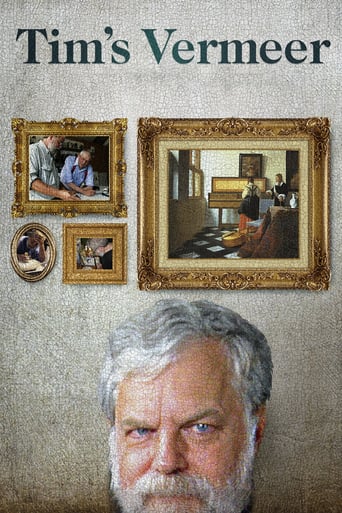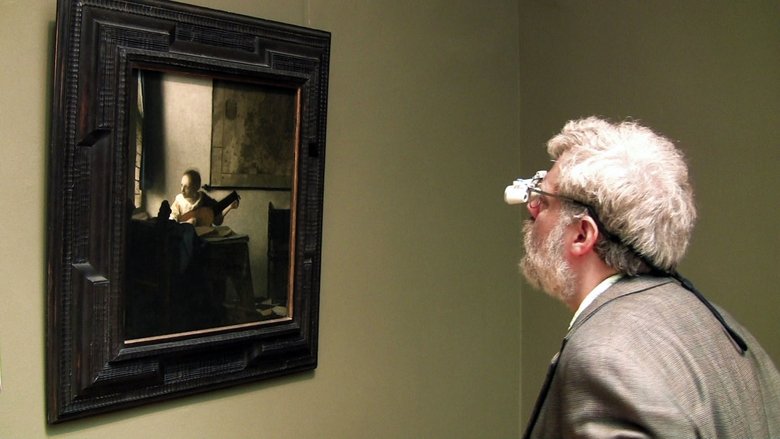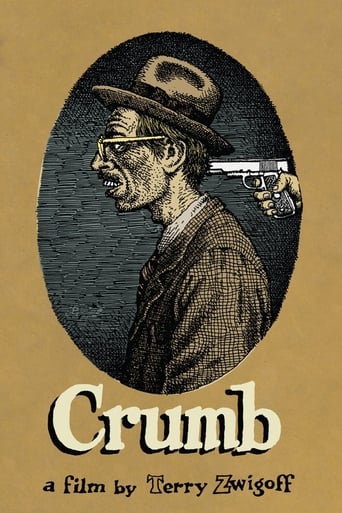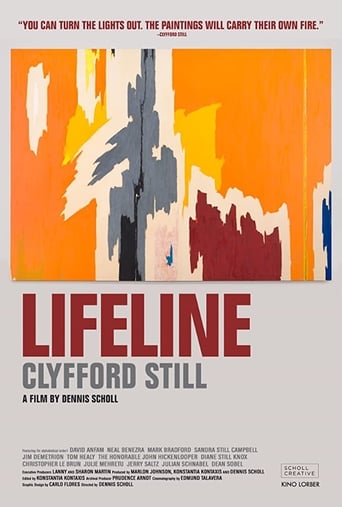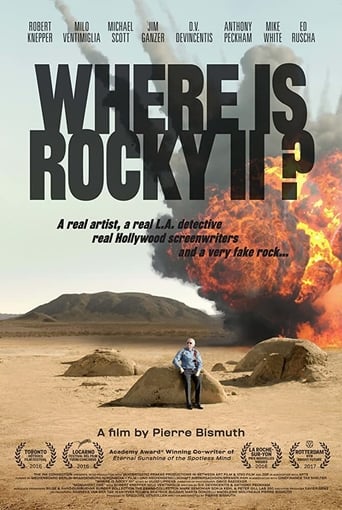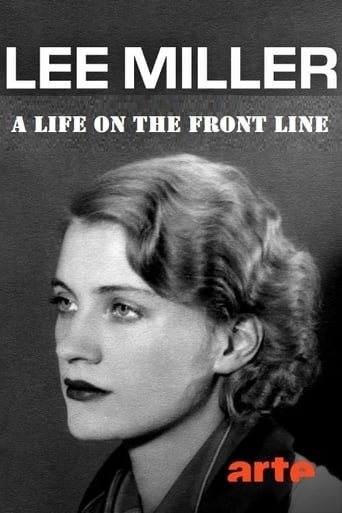Tim's Vermeer (2013)
Tim Jenison, a Texas based inventor, attempts to solve one of the greatest mysteries in all art: How did Dutch Master Johannes Vermeer manage to paint so photo-realistically 150 years before the invention of photography? Spanning a decade, Jenison's adventure takes him to Holland, on a pilgrimage to the North coast of Yorkshire to meet artista David Hockney, and eventually even to Buckingham Palace. The epic research project Jenison embarques on is as extraordinary as what he discovers.
Watch Trailer
Free Trial Channels
Cast


Similar titles
Reviews
Excellent, Without a doubt!!
I gave this film a 9 out of 10, because it was exactly what I expected it to be.
I really wanted to like this movie. I feel terribly cynical trashing it, and that's why I'm giving it a middling 5. Actually, I'm giving it a 5 because there were some superb performances.
Great story, amazing characters, superb action, enthralling cinematography. Yes, this is something I am glad I spent money on.
This USA comedy/magic duo Penn & Teller's passion project is an intriguing documentary attempts to reappraisal the fine line between an artist and an artisan, through Tim Jenison, a successful American inventor, engineer, but an amateur of painting, who pulls his back into precisely duplicating Dutch Golden Age luminary Johannes Vermeer's masterpiece THE MUSIC ROOM with the help of a simple optic gizmo which he believes Vermeer also secretly utilized, or at least in a similar way in his creation. Vermeer was perversely cagey about his painting technique, there is no extant documents where one can sieve through to find any evidence, the only stratagem is from his oeuvres, mostly depicting domestic interior scenes, as the watchword of the film is "every paint is a document of its own". So Tom's hypothesis, which also bolstered by books such as British artist David Hockney's SECRET KNOWLEDGE and VERMEER'S CAMERA written by British architecture professor Philip Steadman, is bold and contentious, if he successes in producing a Vermeer-calibre painting through his experiment, does it debase Vermeer from a masterful artist who is celebrated for his divine treatment of light and capturing a beguiling verisimilitude of reality, to a mere inventor who laboriously but accurately duplicating real-life image onto the canvas thanks to an ingenious gadget borne out of a scientific discovery? Maybe, the art firmament itself has been longly misjudged as this venerable, superior godsend reflecting human's uttermost self-importance has been proverbially and obstinately holds a dismissive slant towards the progress of modern science, where subjectivity always trumps objectivity. The film is conventionally arranged in a simple and linear narrative centers on Tim's painstaking process, spanning over 5 years, from the exhaustive preparation of the paraphernalia which should be exclusively limited within 17th century's knowledgeability, to the reproduce of the entire tableaux exactly like that in THE MUSIC ROOM, until his four-month-long endeavor to create his own Vermeer, certain longueur is inevitable, since his technique is plainly a one-trick-pony and extremely time-consuming (plus, none too many galvanizing vignettes are included), but Conrad Pope's soothing score always comes timely to diffuse the lurking fatigue. When Tim finally finishes his work, circumscribed by film's inherent attribute, audience doesn't have the access to make the judgement by one's own eyes through the screen, so it is somewhat a bit disappointing, the film doesn't include the appraisal from a more canonical collective of voices apart from Steadman and Hockney, nevertheless, it surely tallies with the fact that Vermeer's output is not as prolific as others, by this method, he could maximally produce 3 pieces a year. Due to the fact that any concrete proof is simply not available, this documentary cannot make Tim's viewpoint indisputable, although, in the eye of an art layman, it is remarkably persuasive, or maybe that is not the whole point at all, after all, it is Tim's strenuous perseverance, questioning inclination, scrutinising method and can-do attitude feels more affecting and encouraging in the end of the story.
I would imagine that only art students or avid art collectors would know the name Vermeer if it was spoken out loud, where the rest of us would have to Google his name and learn about this name. Vermeer is actually a name, well a last name in Johannes Vermeer, who was a great painter in the 1600s. His work is known all over the world and is sought after by royalty, celebrities, and very wealthy business people. What makes Vermeer standout than any other painter from the 1600s? Well that's an interesting topic and question. It's such a fascinating subject, that Penn and Teller (the magicians and entertainers) decided to make one of their famous documentaries about it.This matter is is of great interest because Vermeer's paintings are photo-realistic. That is odd, because, it would be very difficult or impossible to capture the lighting, shades, and intricate details that Vermeer captured in his paintings if he did it free hand from memory, which he and people claimed he did. Since Penn and Teller are in the business of calling 'Bullshit', they seemed to have a great beginning to an incredible story, which was how did Vermeer really get the images so detailed in his paintings.Luckily for Penn and Teller, they knew a guy named Tim Jenison, who is a very wealthy technologist, meaning he has invented and sketched the way for new technology over the past few decades. It also means that he might be a bored billionaire with some interesting hobbies, one of those being Vermeer. Tim had a theory that Vermeer in fact did NOT paint these free hand, but rather used new technology at the time to basically trace his paintings, thus he set out to prove his theory, which took seven years to prove from start to finish. Tim's theory stated that Vermeer used a camera obscura, which was fairly new back in the 1600s, to project an image onto a canvas or wall.The projected image is portrayed upside down, but what Tim figured out is if you place a mirror that reflects that image under your eye and on top of your canvas, you have the image that you can sketch perfectly as if you were tracing it. First off, Tim has never painted in his life. Hell, he didn't even know how to hold a paintbrush correctly, but when he attempted to paint a portrait of someone as a trial run, it turned out spectacular, as if he has painted his entire life.After a few more test runs, Tim decided to try this theory on an actual Vermeer painting, specifically the 'The Music Lesson', because of it's intricate and vivid details on the rug and the lighting from the windows. But Tim didn't want to use modern day technology. Instead, he wanted to recreate what it was like for Vermeer in the 1600s. So, being a billionaire, he constructed the room, according to the painting and used the old equipment that Vermeer would have used to get his photo-realistic paintings. And thus the real story is set in motion as Tim spent eight months painting a Vermeer.We get to see the highs and lows of Tim's psyche as he struggles to finish the painting, even saying to the camera "If this wasn't for a movie, I would have quit already." Tim, Penn and Teller, travel to England to meet with some famous artists who reflect on Vermeer and Tim's theory as well as stop by Buckingham Palace to see the actual Vermeer painting, 'The Music Lesson', which is a comical bit in true Penn and Teller form. Throughout the documentary, seeing Tim paint different sections and how the small details are captured, we start to really believe that Vermeer indeed must have used this technique, even if it took many months to complete.And maybe Vermeer wasn't an artist, but one of the first technologists, just like Tim several hundred years later. In the end, Tim painted a Vermeer, and when he showed other art scholars and collectors his piece, they couldn't believe it and said it might just be better than the original. 'Tim's Vermeer' is a short, fun, and interesting documentary about one man's adventure to prove that a celebrated artist might have used technology to help him paint.
I am writing this review purely to say "thank you" to all involved in the making of this documentary. 80 of the best spent minutes of my time recently! To Tim Jenison - What a visionary to solve this puzzle and the generosity to share it with the world. To Penn and Teller - For seeing Tim's project as the incredibly fascinating subject it is and taking the time to document it and share it with us. I know nothing at all about art or invention, but that is not necessary to appreciate the brilliance and patience of this project. An incredible lesson as well for this "want it in an instant" world of the pleasure, benefits and wonderment of taking the time to think and create. Excellent, first class documentary!!
Tim Jenison works out how it was possible for Vermeer to paint what amounts to photo realistic paintings with a great deal of ease. He then builds a full scale room that matches one in a Vermeer painting in order to further prove it.I'm mixed on this film. While I think Tim pretty much proves Vermeer could have used this method to paint the film, I'm still pondering why the film runs 80 minutes especially after 15 he's proved his point. Yes I completely understand that seeing Tim paint the copy is the point but taking it that far raises more questions than are healthy such as how Tim learned to paint and mix colors and how it would be possible for a regular guy to just do it.Don't get me wrong but at a certain point I just wanted to know why this film was longer than say a half an hour.Worth a look but its little more than a Discovery Channel documentary.

